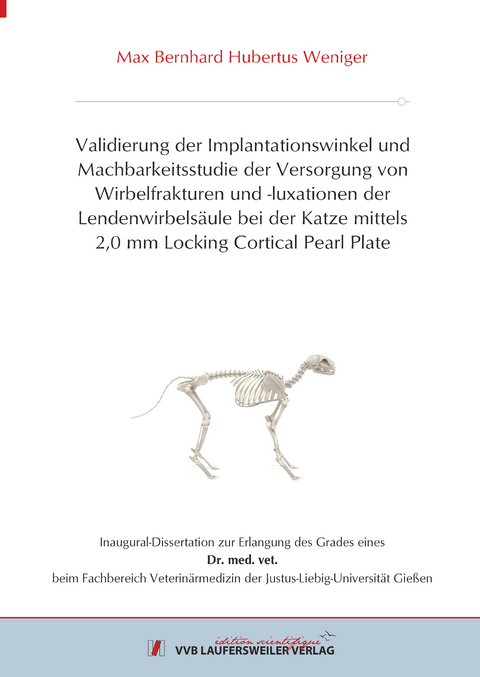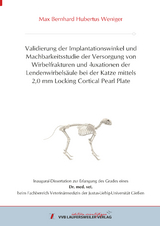Validierung der Implantationswinkel und Machbarkeitsstudie der Versorgung von Wirbelfrakturen und -luxationen der Lendenwirbelsäule bei der Katze mittels 2,0 mm Locking Cortical Pearl Plate
Seiten
2023
VVB Laufersweiler Verlag
978-3-8359-7147-9 (ISBN)
VVB Laufersweiler Verlag
978-3-8359-7147-9 (ISBN)
- Keine Verlagsinformationen verfügbar
- Artikel merken
Die vorliegende Arbeit dient der Praktikabilitätsprüfung der Anwendung eines verriegelten Plattensystems (LCCP der Firma VOl) zur operativen Versorgung von Frakturen und Luxationen der Lendenwirbelsäule der Katze. Im Rahmen dieser Kadaverstudie wurde zunächst eine computertomographische Untersuchung der Lendenwirbelsäule durchgeführt, anhand derer eine Vermessung der Wirbelkörper an vier verschiedenen Lokalisationen zur Detektion potenzieller Implantationskorridore vorgenommen wurde. Im nächsten Schritt wurde das Implantat an der Wirbelsäule eingebracht. Im Anschluss wurde die computertomographische Untersuchung wiederholt, um auf dieser Basis zum einen die Implantationswinkel zu bestimmen und zum anderen mögliche Penetrationen des Wirbelkanals (Breaching) zu beurteilen. Die Ergebnisse der Studie legen nahe, dass das verwendete Implantatsystem für den Wirbelsäulenabschnitt von L1-L5 bei der Katze grundsätzlich geeignet ist. Dies zeigt sich in der sehr geringen Anzahl von Breachings in diesem Bereich. Bei 267 Implantationen tritt dies lediglich in drei Fällen auf, was 1,1% entspricht. Die Implantation ist ohne Schwierigkeiten und in reproduzierbarer Art und Weise durchführbar, was sich in einem mittleren Implantationswinkel von 61,6° spiegelt, der sich sehr nahe am Zielwinkel von 60° befindet. Die Reproduzierbarkeit wird dadurch untermauert, dass es zwischen den einzelnen Wirbelkörpern sowie innerhalb der Korridore der Wirbelkörper selbst zu keinen signifikanten Abweichungen der Implantationswinkel kommt. Als Ursachen kommen, in den Fällen, in denen ein Breaching stattgefunden hat, abweichende Implantationswinkel in Frage, auch wenn sich dies aufgrund des niedrigen Anteils an Breachings bei einer hohen Anzahl an insgesamt durchgeführten Implantationen statistisch nicht eindeutig belegen lässt. Dies spricht wiederum für eine praktikable und sichere Anwendung des Implantates in dem angesprochenen Wirbelsäulenabschnitt. Unterstützt wird diese Annahme durch den Fakt, dass in einer weiten Spanne der Implantationswinkel von 54,2°-72,3° kein einziges Breaching detektiert werden kann. Um dies mit Signifikanzen statistisch zu untermauern, wäre eine deutliche Vergrößerung der Studienpopulation notwendig. Die für den Bereich von L1-L5 angenommene Eignung kann jedoch für die beiden kaudalen Lendenwirbel L6 und im speziellen für L7 nicht ausgesprochen werden. Die fehlende Aussprache der Eignung des verwendeten Implantates speziell für diese beiden Wirbel ist begründet durch eine ausgeprägte Häufung der auftretenden Breachings an diesen Lokalisationen. So entfallen von den über alle Wirbel hinweg insgesamt 32 aufgetreten Breachings 29 Fälle auf die Wirbelkörper L6 und L7, was einen prozentualen Anteil von über 90% darstellt. Als wahrscheinlichste Ursache für das gehäufte Auftreten in diesem Bereich ist die anatomische Beschaffenheit dieser beiden Wirbel in Korridor 3 anzunehmen, in dem nahezu alle Breachings aufgetreten sind.
Ob das verwendete Implantat in dieser Technik auch hinsichtlich biomechanischer Gesichtspunkte als geeignet einzustufen ist, muss in weiteren Studien evaluiert werden. The feasability of using a locking plate system (LCCP from VOl) for the surgical treatment of fractures and dislocations of lumbar spine in cats is evaluated in the present study. As part of this, a computed tomographic examination of the lumbar spine is carried out to measure the heights and widths of the vertebral bodies at four different locations to detect potential implantation corridors. The next step is the surgical insertion of the implant system. After implantation, another computed tomographic examination follows to determine the actual implantation angle and to assess whether or not penetration of the spinal canal (breaching) occurs. Breachings are classified. The results of the study suggest that the implant system used is basically suitable for the spinal column section from L1 to L5 in cats. This is reflected in the very low number of breaches in this area. In 267 implantations, this occurs in only three cases, which corresponds to 1.1%. The implantation can be carried out without difficulties and in a reproducible manner, which is reflected in a mean implantation angle of 61.6° being very close to the target angle of 60°. The reproducibility is underpinned by the fact that there are no significant deviations in the implantation angles between the individual vertebral bodies or within the corridors of the vertebral bodies themselves. Deviating implantation angles in cases where a breach has taken place may be the cause, even if this cannot be clearly proven statistically. However, this is due to the low proportion of breaches in a high number of implantations carried out, which in turn speaks for a practicable and safe use of the implant in the spinal column section in question. This presumption is supported by the fact that in a wide range of implantation angles from 54.2°-72.3° not a single breaching can be detected. In order to clearly substantiate this statistically, a significant increase in the study population would be necessary. In contrast, the suitability assumed for the area from L1 to L5 cannot be pronounced for the two caudal lumbar vertebrae L6 and in particular L7. The lacking recommendation of the suitability of the implant used specifically for these two vertebrae is based on the marked accumulation of occurring breaches at these locations. Of the 32 breaches that occurred in all vertebrae, 29 were in the L6 and L7 vertebrae, which represents a percentage of over 90%. The most likely reason for the clustering in this area appears to be primarily the anatomical nature of these two vertebrae. Especially regarding corridor 3, where nearly all breaches occurred.
Whether the implant used in this technique can also be classified as suitable from a biomechanical point of view must be evaluated in further studies.
Ob das verwendete Implantat in dieser Technik auch hinsichtlich biomechanischer Gesichtspunkte als geeignet einzustufen ist, muss in weiteren Studien evaluiert werden. The feasability of using a locking plate system (LCCP from VOl) for the surgical treatment of fractures and dislocations of lumbar spine in cats is evaluated in the present study. As part of this, a computed tomographic examination of the lumbar spine is carried out to measure the heights and widths of the vertebral bodies at four different locations to detect potential implantation corridors. The next step is the surgical insertion of the implant system. After implantation, another computed tomographic examination follows to determine the actual implantation angle and to assess whether or not penetration of the spinal canal (breaching) occurs. Breachings are classified. The results of the study suggest that the implant system used is basically suitable for the spinal column section from L1 to L5 in cats. This is reflected in the very low number of breaches in this area. In 267 implantations, this occurs in only three cases, which corresponds to 1.1%. The implantation can be carried out without difficulties and in a reproducible manner, which is reflected in a mean implantation angle of 61.6° being very close to the target angle of 60°. The reproducibility is underpinned by the fact that there are no significant deviations in the implantation angles between the individual vertebral bodies or within the corridors of the vertebral bodies themselves. Deviating implantation angles in cases where a breach has taken place may be the cause, even if this cannot be clearly proven statistically. However, this is due to the low proportion of breaches in a high number of implantations carried out, which in turn speaks for a practicable and safe use of the implant in the spinal column section in question. This presumption is supported by the fact that in a wide range of implantation angles from 54.2°-72.3° not a single breaching can be detected. In order to clearly substantiate this statistically, a significant increase in the study population would be necessary. In contrast, the suitability assumed for the area from L1 to L5 cannot be pronounced for the two caudal lumbar vertebrae L6 and in particular L7. The lacking recommendation of the suitability of the implant used specifically for these two vertebrae is based on the marked accumulation of occurring breaches at these locations. Of the 32 breaches that occurred in all vertebrae, 29 were in the L6 and L7 vertebrae, which represents a percentage of over 90%. The most likely reason for the clustering in this area appears to be primarily the anatomical nature of these two vertebrae. Especially regarding corridor 3, where nearly all breaches occurred.
Whether the implant used in this technique can also be classified as suitable from a biomechanical point of view must be evaluated in further studies.
| Erscheinungsdatum | 04.10.2023 |
|---|---|
| Reihe/Serie | Edition Scientifique |
| Verlagsort | Gießen |
| Sprache | deutsch |
| Maße | 145 x 215 mm |
| Gewicht | 320 g |
| Themenwelt | Veterinärmedizin ► Allgemein |
| Veterinärmedizin ► Kleintier | |
| Schlagworte | Brüche • Gelenke • Gleitwirbel • Knochen • Luxationen • Osteo |
| ISBN-10 | 3-8359-7147-6 / 3835971476 |
| ISBN-13 | 978-3-8359-7147-9 / 9783835971479 |
| Zustand | Neuware |
| Haben Sie eine Frage zum Produkt? |

